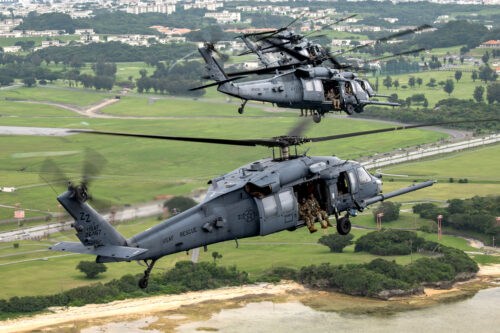The 33rd Rescue Squadron (RQS) of the U.S. Air Force commemorated the storied legacy of the HH-60G Pave Hawk helicopter with a formation flight, marking the imminent transition to the newer HH-60W “Whiskey” model for the unit based in Japan.

Since its introduction in 1982, the HH-60G Pave Hawk has served as a vital asset for the U.S. Air Force, conducting countless missions in diverse environments. From perilous combat search and rescue (CSAR) operations to disaster relief efforts, the Pave Hawk has earned a reputation for saving lives under the most demanding conditions.
“The G model is an amazing aircraft,” said Lt. Col. Louis Nolting, commander of the 33rd RQS. Built upon the Black Hawk platform and incorporating lessons learned from Vietnam, the HH-60G boasts enhanced survivability, advanced avionics, weapon systems, hoists, and aerial refueling capabilities. These features have made it a vital asset for combat search and rescue (CSAR), disaster relief, casualty evacuation (CASEVAC), and medical evacuation (MEDEVAC) missions.
The Pave Hawk’s legacy encompasses a wide range of operations. From the deserts of the Middle East to the stormy Pacific seas, it has served valiantly in conflicts like Desert Storm and Operation Tomodachi. Beyond combat zones, the Pave Hawk has played a crucial role in humanitarian missions across Africa and disaster response efforts like Hurricane Katrina. Master Sgt. Jeffrey Hegstrom, a special missions aviator with the 33rd RQS, emphasized the Pave Hawk’s reliability and versatility, particularly in challenging environments where other aircraft are unsuitable. “The Golf has shown time and time again that it’s more than capable for combat search and rescue operations in any environment,” Hegstrom was quoted as saying.
Staff Sgt. Andrew French, a flying crew chief with the 718th Aircraft Maintenance Squadron, acknowledges the immense responsibility of maintaining these multi-million dollar aircraft. However, he finds immense satisfaction in knowing his work directly contributes to saving lives and reuniting families.
Lt. Col. Nolting concludes by highlighting the unparalleled legacy of the HH-60G Pave Hawk. The countless lives saved and its unwavering performance stand as testaments to its exceptional capabilities. As the Pave Hawk retires from service, the 33rd RQS prepares to embrace the challenges and opportunities presented by the HH-60W, ensuring the continuity of their vital lifesaving mission.
For more information, hit the Source below